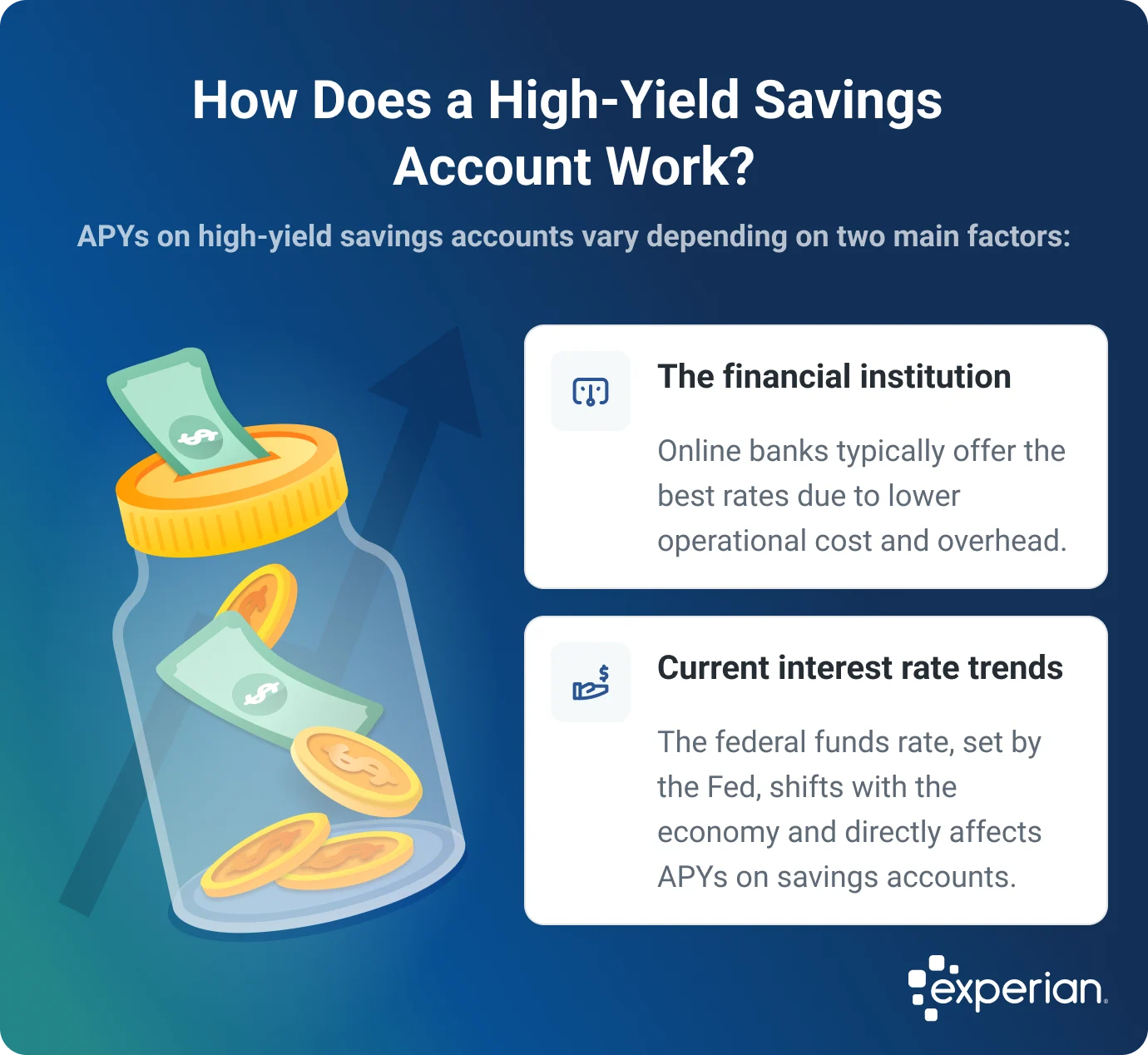What Is a High-Yield Savings Account?
Quick Answer
High-yield savings accounts offer above-average interest rates. That can help your money grow faster, and many come with low or no fees. Online banks tend to have the highest APYs.

As the name implies, high-yield savings accounts offer higher interest rates than traditional savings accounts. That can allow your money to grow a little faster without exposing you to investment risk—and the more you deposit, the more you stand to earn. Every financial institution is different, so it's smart to compare rates, fees and accessibility. Let's talk about how a high-yield savings account works, the pros and cons, and how to open one.
What Is a High-Yield Savings Account?
Like a traditional savings account, a high-yield savings account pays out interest on your deposits—but you can expect a stronger annual percentage yield (APY). This is your actual rate of return over the course of a year. If you have a substantial amount in savings, a savings account with a high yield could be a simple way to earn much more. That could make it the ideal holding place for your emergency fund. (The general rule is to set aside three to six months' worth of expenses.)
A high-yield savings account can also make sense if you're saving for short-term financial goals. That might include starting a business, traveling or preparing for a period of unpaid parental leave. While you might also get a high yield with a certificate of deposit (CD), your money will be locked in the account for the duration of the CD's term—and withdrawing funds from a CD early usually triggers a penalty. High-yield savings accounts offer more flexibility, making it easy to tap your money when needed, often at no fee.
Earn Money Faster
Compare high-yield savings accounts
Find a high-yield savings account with today’s APY. Compare current APY and offers to find the best savings account for you.
How Does a High-Yield Savings Account Work?
APYs on high-yield savings accounts vary depending on two main factors:
- The financial institution: Online banks typically offer the best rates on high-yield savings accounts. That's because they tend to have less overhead and lower operational expenses, which allows them to offer better rates and lower fees.
- Current interest rate trends: The federal funds rate plays an important role here. This benchmark rate, set by the Federal Reserve, is used by banks to lend cash to each other. The federal funds rate changes over time, often in response to economic conditions like inflation or a recession. It also influences APYs on savings accounts, including those with a high yield. When the federal funds rate goes up or down, APYs usually do the same.
The best high-yield savings accounts are ones that offer competitive rates and charge little or no fees. As of June 2025, the Federal Deposit Insurance Corp. (FDIC) puts the average rate for a traditional savings account at just 0.42%. Meanwhile, some high-yield accounts have rates as high as 5%.

Let's say you have $10,000 in savings and interest compounds daily. Here's how much interest you could earn after a year in a high-yield savings account versus a traditional savings account.
| Traditional Savings Account | High-Yield Savings Account | |
|---|---|---|
| Starting balance | $10,000 | $10,000 |
| APY | 0.42% | 4.66% |
| Total interest earned | $42 | $477 |
| Balance after one year | $10,042 | $10,477 |
Learn more: How Does Interest Work on a Savings Account?
Pros and Cons of High-Yield Savings Accounts
High-yield savings accounts have plenty of benefits, but there are also some downsides to consider. Understanding the pros and cons can help you decide if it's right for you.
Pros
-
Higher-than-average interest rates: Earning a high yield on your funds is probably the most compelling reason to stash your money in a high-yield savings account. It can also motivate you to prioritize saving.
-
Very little risk: Virtually all high-yield savings accounts are FDIC-insured for up to $250,000 per depositor, per insured bank for each account category. You can expect similar coverage from credit unions. That means your money would be safe in the unlikely event your financial institution fails.
-
Easy access to funds: Unlike a certificate of deposit (CD) or tax-deferred account like a 401(k), it's relatively easy to pull money from a high-yield savings account. You can link it to your checking account and transfer funds as needed. You'll likely have ATM access as well.
Cons
-
Potential fees: Some banks tack on fees if you exceed six electronic transfers and withdrawals per month. You might also be charged overdraft fees, minimum balance fees or maintenance fees.
-
Lower returns than other investments: You'll likely secure better returns with investments that are tied to the stock market. These carry more risk, but investing is often a key part of building a strong nest egg—especially for retirement. That can help your savings keep pace with inflation over time.
-
Fewer physical branches: If you go with an online bank, you won't have access to brick-and-mortar locations. That may be an issue if you prefer to do your banking in person. Either way, you'll want to make sure you have a robust ATM network before opening an account.
How to Open a High-Yield Savings Account
Knowing what to expect can help streamline the process. Here's a simple step-by-step guide to opening a high-yield savings account.
1. Select an Account
When choosing a high-yield savings account, remember that every financial institution is different. Be sure to compare the following:
- Interest rates
- Fees
- Opening deposit requirements
- ATM access
- Customer reviews
When shopping around, you may come across excessive fees or find that the best rates are reserved for customers who maintain a certain balance. These details can help you weed out certain accounts and point you toward one that can help you get the most out of your savings.
2. Get Your Documents Ready
You'll likely need to have the following information on hand when opening a high-yield savings account:
- Driver's license, passport or other government-issued photo ID
- Another form of identification, which may be your Social Security card or birth certificate
- Name, address, phone number and other basic contact information
Visit the bank or credit union's website before applying to clarify what documents you'll need to open an account.
3. Complete Your Application
You can likely do this online, making it that much easier to get your high-yield savings account up and running. However, your bank or credit union may allow you to complete the process in person if you prefer. Either way, your ChexSystems report will be a deciding factor. It provides a snapshot of your bank account history. You may have trouble qualifying if you've had prior:
- Bounced checks
- Overdrafts
- Involuntary account closures
- Unpaid fees
- Outstanding negative balances
4. Fund Your High-Yield Savings Account
Once your account is open, you can make your opening deposit and begin using it. This can be as simple as transferring funds from another account. It's also wise to schedule automatic monthly deposits to keep your account growing—and allow you to earn even more interest. You can also set up account alerts and familiarize yourself with your bank or credit union's online platform and mobile app.
Frequently Asked Questions
The Bottom Line
A high-yield savings account can be a handy tool that helps grow your money at a faster rate. They often tout low or no fees and higher rates than standard savings accounts. You can also rest easy knowing that your money is safe. Consider it one part of an overarching financial plan. It's also wise to diversify your investment portfolio and be strategic about saving for long-term goals like retirement.
Earn more with a high-yield savings account
Make your money work harder with a high-yield savings account—earn higher returns with easy access to your funds.
Compare accountsAbout the author
Marianne Hayes is a longtime freelance writer who's been covering personal finance for nearly a decade. She specializes in everything from debt management and budgeting to investing and saving. Marianne has written for CNBC, Redbook, Cosmopolitan, Good Housekeeping and more.
Read more from Marianne